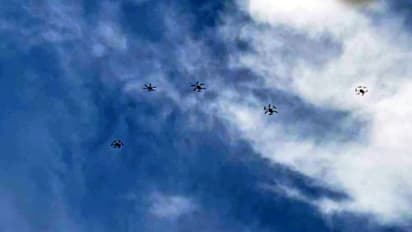India deploys 'swarm drones' along China and Pakistan borders

Synopsis
The swarm drone system consists of a number of aerial vehicles, which are artificial intelligence-enabled and capable of communicating with the control station as well as among them. They can be employed in both offensive and defensive operations, providing a decisive edge to the tactical commanders employing them.
Aimed at gathering intelligence and enhancing the combat potential of the troops, the Indian Army has recently inducted 'swarm drones' and deployed them along the borders with Pakistan and China to thwart any activities that undermine the country's sovereignty.
Considered a force multiplier in military operations, the swarm drones can be used in offensive and defensive roles. It can provide surveillance inputs, undertake close recce of a particular area to confirm inputs from other intelligence, surveillance and reconnaissance resources, and engage varied targets like artillery and air-defence equipment, enemy command and control centres and opportunities.
Also Read: India to induct light tank 'Zorawar' for mountain warfare
Drone technologies have been used in several recent global conflicts like Armenia and Azerbaijan, Syria and strikes on oilfields in Saudi Arabia and in the ongoing Russia-Ukraine conflict.
Sources in the defence establishment said: "Even in our context, the recent incidents along the borders have seen a noticeable increase in drone-related incidents along our Borders."
What are swarm drones?
It is a group of drones operating in conjunction with the ground manoeuvre forces that provide an aerial manoeuvre capability during both offensive and defensive operations. It enhances the combat potential of the ground forces.
The swarm drone system consists of a number of aerial vehicles, which are artificial intelligence-enabled and capable of communicating with the control station as well as among them.
It also enables the swarm drones to automatically distribute the tasks among themselves, navigate to the area of interest, ensure collision avoidance during movement to the target area and carry out a search of the area.
Artificial Intelligence-based Automatic Target Recognition feature enables the drones to automatically recognise targets, line tanks, guns, vehicles and humans and display them on the control station screen, thus minimizing the chances of the operator missing any target and also facilitating engagement by suitable type of weapon platform.
Sources added, "We need swarm drones to provide tactical commanders with a force multiplier. They can be employed in both offensive and defensive operations, providing a decisive edge to the tactical commanders employing them."
Besides, the Indian Army has also initiated a Make-II case, Autonomous Surveillance and Armed Drone Swarm (A-SADS), which includes a number of improvements and also a version for High Altitude Areas.
Also Read: IAF Su-30 MKI fighter jets join 'Pitch Black' missions
Also Read: Rafale-M Vs F/A-18: Foreign fighter jets to be on aircraft carrier Vikrant as 'interim arrangement'
Also Read: Nepal is not ready for Agnipath, delays recruitment for Indian Army
Stay updated with the Breaking News Today and Latest News from across India and around the world. Get real-time updates, in-depth analysis, and comprehensive coverage of India News, World News, Indian Defence News, Kerala News, and Karnataka News. From politics to current affairs, follow every major story as it unfolds. Download the Asianet News Official App to stay informed anytime, anywhere.